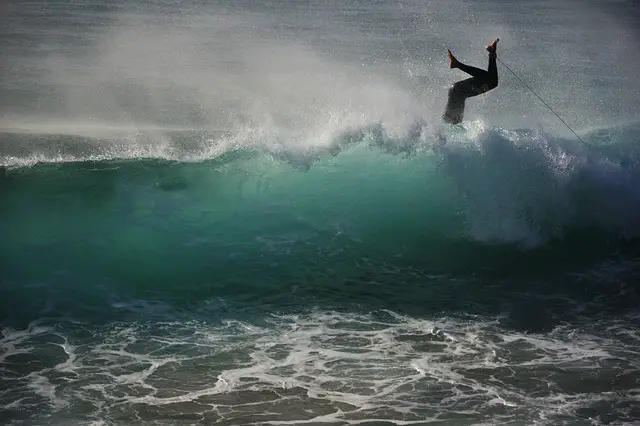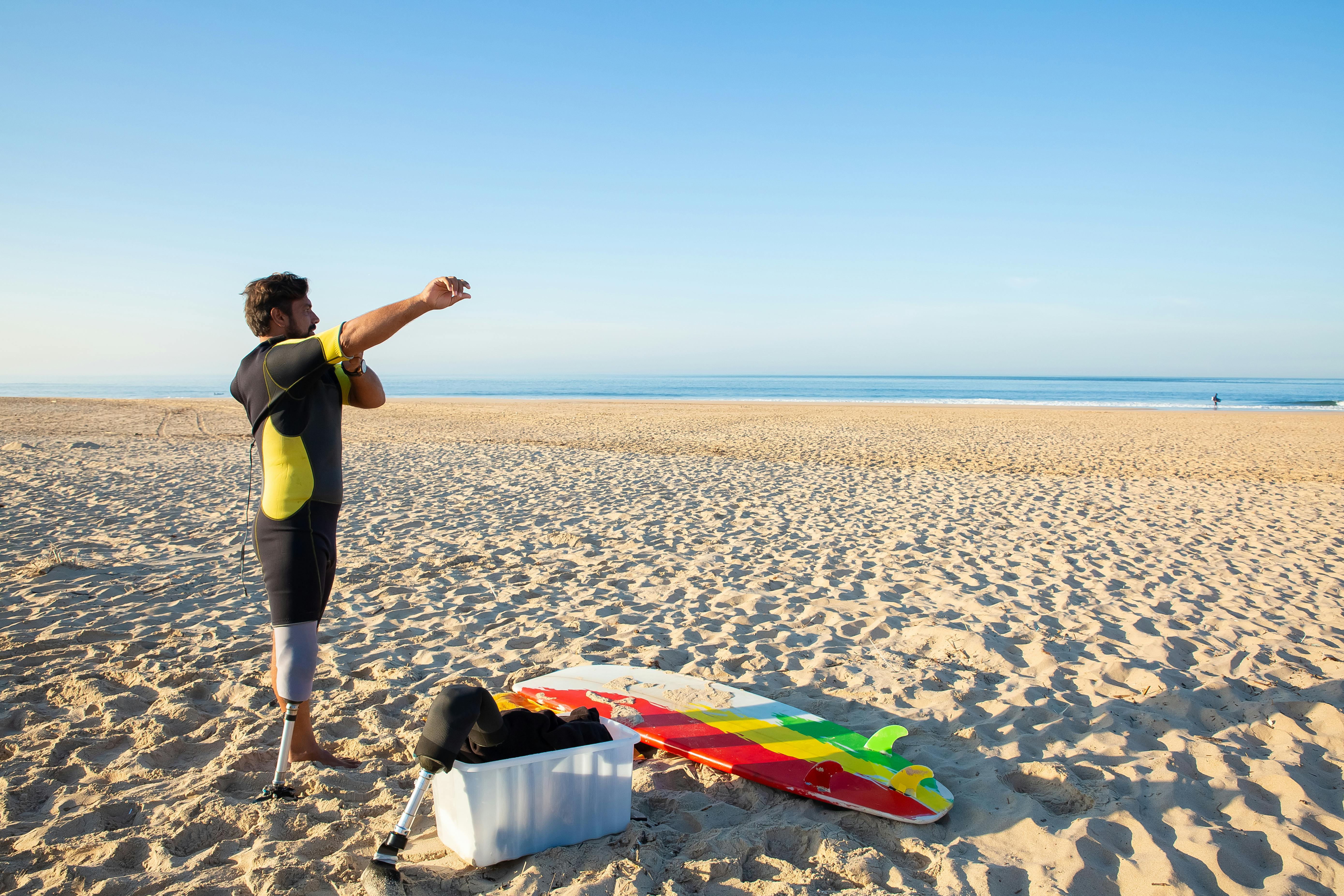What Do You Wear Under A Wetsuit

When it comes to underwater activities, a wetsuit is an essential piece of clothing. But what do you wear under a wetsuit? Knowing what to wear under a wetsuit can make all the difference in terms of comfort and warmth. Depending on the type of activity and the water temperature, there are several options for what you can wear beneath your wetsuit. In this article, we’ll explain how to choose the right clothing for your next water adventure.The best undergarment to wear under a wetsuit is a thin, form-fitting rash guard. Rash guards are made from a stretchy, quick-drying material and help protect your skin from irritation caused by the wetsuit. They also provide extra insulation and warmth so you can stay comfortable in cold water.
Different Types of Undersuits for Wetsuits
Wetsuits are essential for a variety of water activities, such as surfing, scuba diving, and other water sports. An undersuit can help provide additional warmth and insulation to the wetsuit, making it more comfortable to wear in cold waters. There are several different types of undersuits available, each designed for different activities and levels of comfort. The most common types are fleece, neoprene, and lycra.
Fleece undersuits are made from lightweight synthetic fibers that provide extra warmth without adding bulk or weight. They are commonly used by surfers and divers in colder climates who want to maximize their protection from the cold. They come in a variety of styles and colors so you can find something that fits your personal style.
Neoprene undersuits are thicker than fleece suits and provide more insulation against the cold. They also add some compression to the wetsuit which helps keep the body warm by preventing the cold water from entering through any openings in the suit. Neoprene suits are ideal for serious divers who need maximum protection from the cold waters they encounter.
Lycra undersuits are designed to be lightweight and comfortable while still providing some insulation against the cold. Lycra is very stretchy so it fits snugly against the body without being restrictive or uncomfortable. It is often used for warmer waters where an extra layer of insulation isn’t necessary but some warmth is still desired.
No matter what type of undersuit you choose, it’s important to make sure it fits properly under your wetsuit so you can enjoy maximum comfort and protection when you’re out on the water. Each type has its own benefits so be sure to consider your needs before making a purchase.
What Are The Benefits Of Wearing An Undersuit?
An undersuit is a great way to stay warm and comfortable in cold weather conditions. Undersuits are made of lightweight materials that provide an extra layer of insulation that helps keep the body temperature regulated. They also provide a barrier between the skin and any cold surface, such as snow or ice. Additionally, an undersuit can help protect against wind chill and help reduce the risk of hypothermia.
Undersuits are designed to be comfortable and breathable, so they won’t weigh you down or cause discomfort while wearing them. They are also very easy to take on and off, making them great for layering with other pieces of clothing to provide additional warmth when needed.
Wearing an undersuit can also help protect your skin from abrasions and scrapes that can occur during outdoor activities in cold weather conditions like skiing or snowboarding. The material is designed to be durable enough to withstand contact with the elements while still providing protection against minor injuries.
The versatility of undersuits makes them great for all types of outdoor activities throughout the year, from winter sports to summer camping trips. They are lightweight enough to wear under regular clothing or as a standalone piece when temperatures drop significantly. Whether you’re looking for an extra layer of protection in cold weather or just want a comfortable piece of clothing for outdoor activities, an undersuit is sure to come in handy!
What Materials Make The Best Undersuits?
When it comes to finding the best undersuits for any activity, the material is key. Undersuits are typically made from different types of fabrics and materials, all designed to provide insulation, warmth, and protection. The type of fabric used in an undersuit will depend on the intended purpose.
For colder climates and activities such as skiing or snowboarding, a fleece-lined undersuit can provide excellent insulation against the cold. Fleece is lightweight and breathable, so it is great for keeping sweat away from your body. It also retains heat well, so it is great for keeping you warm in cold climates.
For wet weather activities such as sailing or surfing, a synthetic undersuit with a waterproof and windproof membrane can provide excellent protection against the elements while still allowing for ventilation and breathability. These fabrics are designed to keep you dry while providing insulation from the cold.
For activities that involve high-intensity physical activity such as running or cycling, a lightweight undersuit made from moisture-wicking fabrics can help keep your body cool by drawing sweat away from your skin. These types of fabrics are also designed to be breathable and flexible so that they won’t restrict movement during physical activity.
No matter what type of activity or climate you’re planning on facing, finding an undersuit that is made from quality materials and designed for your intended purpose is essential in ensuring comfort and performance during your adventure.
Pros and Cons of Wearing an Undergarment Under a Wetsuit
Wearing an undergarment under a wetsuit can provide comfort and warmth while surfers are out in the water. However, there are both pros and cons to wearing an undergarment. Here are some things to consider before deciding whether or not to wear an undergarment.
One of the biggest pros of wearing an undergarment is that it provides extra insulation against the cold water. This can help keep a surfer warm and comfortable while they are out in the water, even in cold temperatures. An undergarment can also provide extra protection against chafing from the wetsuit material, which can be especially helpful for those with sensitive skin.
On the other hand, there are some drawbacks to wearing an undergarment. First, it can be difficult to find one that fits properly. Different wetsuits come in different sizes, so finding one that fits correctly might require some trial and error. Additionally, it is important to make sure that the material is breathable and moisture-wicking so that it doesn’t get too hot or uncomfortable while wearing a wetsuit for long periods of time.
Overall, there are both pros and cons to wearing an undergarment when surfing in a wetsuit. It’s important to consider all factors before deciding whether or not it’s right for you. If you do decide to wear one, make sure you find one that fits properly and offers enough insulation without being too hot or uncomfortable for extended periods of time in the water.

How To Choose The Right Undersuit For Your Body Type
Choosing the right undersuit is an important step in keeping yourself comfortable and looking your best. The right undersuit can highlight your natural shape and make you look slimmer, while a wrong one can make you look bulky or saggy. Knowing your body type is key to choosing the right undersuit for you. Here are some tips to help you find the perfect undersuit for your body type.
For Apple Shaped Bodies
Apple shaped bodies are characterized by wider chests and waists, with less definition in the hips and legs. To flatter this body type, look for undersuits with a longer cut that skims the waistline. A v-neck style will also help to create more definition in the upper body. Avoid boxy shapes as these will add bulk to your frame, instead opt for something that gives a bit of shape without being too tight.
For Pear Shaped Bodies
Pear shaped bodies have a wider lower half with narrower shoulders and chest. To emphasize this shape, look for undersuits with bold colors on top and darker colors on bottom. This will help to draw attention away from the lower half while still emphasizing your curves. Also consider styles that have ruching on the sides or back as these will give you extra definition without clinging too tightly to the midsection.
For Hourglass Shaped Bodies
Hourglass shaped bodies have balanced proportions between their shoulders, chest, waist and hips. To show off this figure, choose an undersuit that fits closely but still allows for movement without being restrictive or overly tight. Look for styles that feature details such as contrast panels or color blocking which will help to highlight your curves in all the right places.
For Rectangle Shaped Bodies
Rectangle shaped bodies have relatively straight lines across their chest and waist with little definition at either end of their torso. To create more shape in this body type, choose an undersuit with more fitted panels around the bust area which will help define your silhouette and draw attention away from any excess fabric around the middle area of your torso. A v-neck style is also recommended as it helps elongate your torso and create a slimming effect overall.
By considering these tips when selecting an undersuit according to your body type, you can be sure to find something that is both comfortable and flattering at the same time!
Wash your undersuit regularly
It’s important to keep your undersuit clean and odor-free. You should wash it after every use, or at least once a week. Use a mild detergent and cold water to preserve the fabric. If you’re washing by hand, soak it in a basin of cold water for no more than 10 minutes before pressing the excess water out and hanging it up to dry. If you’re washing in a machine, select the gentle cycle and turn the undersuit inside out to protect the fabric from snagging or stretching. Avoid using bleach or fabric softeners as these products can damage the fabric.
Choose a loose-fitting undersuit
It’s important to choose an undersuit that fits correctly for optimal comfort and performance. Look for materials that are breathable and lightweight with flatlock seams to reduce irritation while still providing warmth. Avoid overly tight-fitting suits as they can restrict movement and cause discomfort while you’re exercising or participating in outdoor activities.
Store your undersuit properly
When your undersuit is not in use, hang it up so that it has plenty of room to breathe. Avoid folding or bunching up the suit as this can cause creasing and wrinkling which can affect how warm the suit is when worn next time. If storing for an extended period of time, wrap it in tissue paper before packing away in an airtight container or garment bag.
Remove stains quickly
If you get mud, dirt or sweat on your undersuit, try to remove them immediately using a damp cloth with mild detergent and cold water. Do not rub too hard as this may damage the fabric fibers of the suit. Afterwards, rinse off any remaining detergent with cold water before allowing it to air dry completely.
How To Fit An Undersuit Properly
An undersuit is a vital part of any outdoor activity, from skiing to rock climbing. It helps keep you warm and comfortable in cold temperatures. Properly fitting an undersuit is key to staying safe and comfortable while enjoying the outdoors. Here are some tips for properly fitting an undersuit:
The first step in fitting an undersuit is to measure yourself accurately. You will need your chest, waist, inseam and arm length measurements. Once you have these measurements, compare them to the manufacturer’s size chart to find the right size for you. Make sure that the fit is snug but not too tight. If it feels too tight or restrictive, go up one size.
Next, try on the undersuit with all of the necessary layers underneath it. This includes base layers such as long underwear and thermal shirts, as well as any additional layers that you may need such as a jacket or vest. Make sure that you can move freely in the suit without any restrictions or binding.
Once you’ve found a suit that fits properly with all of your necessary layers underneath it, adjust all of the straps for a snug fit. The straps should be adjusted so that they fit snugly but not too tightly against your body. Additionally, make sure that all of the zippers are zipped up correctly and securely.
Finally, make sure to check for any gaps between your body and the undersuit. If there are gaps between your body and the suit, this can cause air to get in which can make you colder — not what you want when out on a cold day!
By following these simple steps for properly fitting an undersuit, you can enjoy all your favorite outdoor activities while staying warm and safe!

Conclusion
It is important to consider what to wear under a wetsuit as it can make a huge difference to how comfortable you feel whilst in the water. The type of material you choose and the thickness of the layers are key factors when deciding what clothing to wear underneath a wetsuit. You should also consider how long you plan on being in the water, as this can dictate whether or not you need additional insulation. Ultimately, the best thing to do is to experiment with different combinations until you find one that works for you.
No matter what activities you are taking part in, wearing appropriate clothing underneath your wetsuit will always be beneficial. With a little bit of research and some trial and error, it is easy to find the right combination of base layers that will keep you warm and comfortable when taking part in water sports.
